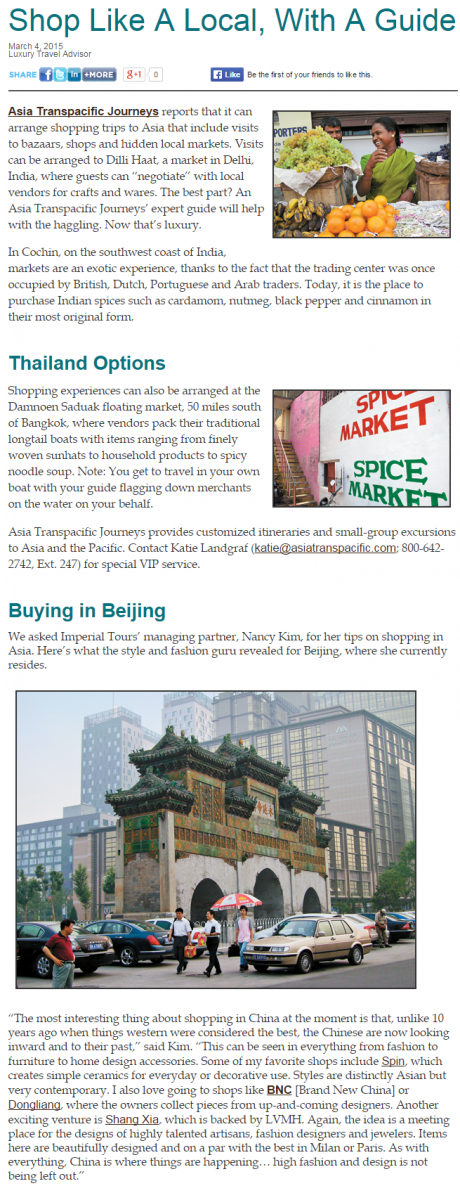Daily life in China has become so reliant on using smart phone apps that I now wonder if I could survive without them! The obvious immediate obstacle for a tourist is flagging down taxis as these exclusively respond to ride-hailing apps now. That said, even though local Chinese people are using their smart phones to handle all their daily tasks from paying their phone bill, to ordering cinema tickets to renting a bike, it is NOW possible for tourists not only to get about, but also to take advantage of Chinese super-apps to facilitate their travel in China. Find out how you should best prepare for a trip to China (as of summer 2023).
Getting a Good VPN.
Any article about digital China for a westerner begins with the absolute necessity of downloading a high quality VPN. Many of the west’s favourite apps, such as Google, Gmail, Facebook, Instagram, Whatsapp, Google Maps and Google Translate are not accessible from China without one. A VPN creates a way for you to tunnel digitally through China’s Great Firewall and access these much-loved apps that are banned in China. My experience is that China’s Great Firewall has different levels of control. During a People’s Congress when Beijing is locked down tight, even the best VPN’s do not work. However, at normal times, the Great Firewall is porous. I’m not going to recommend a particular VPN in this article, but if you are thinking to use a free or a low-cost VPN, bear in mind that you generally get what you pay for. And if you arrive in China with a VPN that is ineffective, your challenge will be to download a high-quality VPN from inside China, which is that much harder (though still doable). (Android phone users should also remember that Google Play cannot be used from inside China, so if they do not have a VPN installed, they are not going to be able to install a new VPN service in China, unless they find a wifi service which already has it.) My final suggestion in this regard is in fact to download two high quality VPNs prior to your trip to China, so that if one does not work, you can try to use the other.
How to pay with an APP
Two super-apps take up the lion’s share of Chinese users’ attention, similar to how Google and Facebook divide the western digital universe between them. In China, these are Wechat and Alipay, the former established by a company called Tencent and the latter created by Jack Ma, the iconic Chinese entrepreneur behind Alibaba. The most significant feature of both is that they have established themselves for mobile payment services covering payments as wide-ranging as to the taxi driver, utility companies and for cinema bookings. Both buttress this payment service with a panoply of mini-apps supplying everything from food delivery to insurance to translation. Theis wide range of services has led to them being known as super-apps. The idea is that they are a digital one-stop shop. We don’t yet have anything like it in the west – it would be like trying to use Amazon or Apple for all our digital needs.
Until now, overseas travelers to China have experienced real problems using anything but cash to pay for goods and services in China as only a limited number of retailers accept overseas credit cards. Although it is illegal in China for retailers to refuse cash as payment, the practical reality where almost no one is using it means that outlets are increasingly unprepared to accommodate it. The great news is that now if they have either a Mastercard or a Visa credit or debit card international travelers can register and use these with the English language versions of Alipay and Wechat. After doing so, not only can overseas travelers use Alipay and Wechat to pay for services in China, but they will also benefit from the various English language mini-apps offered on either app. Alipay was the first to announce their tie-up with Mastercard in June 2023 and instructions for how to link your Mastercard to Alipay can be found here.
Wechat announced at the end of this same month, June 2023, that they will allow overseas visitors to register their international Visa, Mastercard, JCB and Discover cards in their app from August 2023. Details for how to go about doing this can be found here. (Wechat previously had a facility to allow registration of overseas credit cards on their app, but this did not always translate into being able to make payments at many retail outlets in China.)
Please note that for both Wechat and Alipay that after travelers sign up for accounts in their home countries, they will be asked to re-enter passport information and take a selfie after they have arrived in China. This is a second stage in the sign-up process that was in effect in November 2024.
English Language Alipay Services
The scan function on the top left of the home page will enable you to pay for services, provided that your Mastercard is linked to the Alipay account. The transport icon facilitates for you to get about on the bus, by metro, hail a cab as well as buy train and plane tickets. In the “How—to” icon you can use the online translation service, where an image of Chinese text will be instantly converted into English for you. This could be useful in ordering food at a restaurant or trying to work out the destination of trains and planes at stations and airports.
English Langage Wechat Services
To use Wechat to pay for stuff, press the encircled + icon in the top right corner and select “Money” to allow others to scan you, or “Scan” for you to scan others’ payment codes, depending on the situation and payment format. In addition to payment, Wechat is known for its messaging service – it is in effect the Chinese version of Whatsapp with Wechat probably more widespread in China than Whatsapp is in the west. You are safe to assume that everyone you meet in China will have a Wechat account and so if you want to stay in touch and communicate with Chinese people this is the best possible way. (You will also probably find that many of your overseas Chinese friends back home already have a Wechat account.) To get someone’s contact, click the encircled + icon in the top right hand corner and click on “Add Contacts”, then either scan their QR code or select “My Weixin ID” to allow them to scan your code. (Wechat in Chinese is called weixin.)
Translation
As you can only use Google Translate inside China with a VPN, another excellent translation app for you to consider downloading prior to travel here is DeepL. You paste text into the window and can choose to translate it quickly and accurately into any number of languages.
Navigation
If you are an Iphone user, then Apple Maps will work for you in China in English, and this is your best bet. Note that Google Maps does not work in China even with a VPN. The Map function on the Bing.com website will be all in Chinese. Similarly, popular local Chinese navigation apps like Baidu and Gaode are all in Chinese without English functionality. The only remaining option for Android users seems to be downloading an English language map from Map.Me. These are maps that you download onto your phone offline for use in China. They are available for China at a provincial or in more detail at a city level. These were useful in getting me between well-known destinations, such as a large hotel to a well-known tourist site, but when I tried finding a particular noodle store, this was not included in the map database. Therefore, this is a solid back up for most situations, but isn’t as complete as what you’re probably used to back home.
Booking Travel E.g. Hotels, Trains and Airplanes
Trip.com is a fabulous English language engine for easily and efficiently booking hotels, train tickets and airplanes in China.
Other
If you speak some Chinese, I’d also recommend you download the following apps prior to a trip to China:
– Dianping is a terrific app for restaurant reviews and bookings.
– Didi and Gaode are commonly used for ride-hailing, the latter also having a popular mapping function.
– Taobao and JD are the best for online shopping
– Ele.me and Meituan are popular for ordering food deliveries and groceries.
I hope this article has opened your eyes to the enrichment that China’s digital app universe can provide to your travels in China, as well as intimating the depth and ubiquity of apps in Chinese daily life, whether in the city or countryside. At the time of writing this article, Alipay and Wechat had only just started to accept overseas credit cards onto their platforms. The English language versions of these super-apps offer a limited range of English language mini-apps, but I’d hope that as time goes by, they will offer a wider range of traveler-friendly apps.
If you found this article helpful, please do write in with comments after your China trip on how you found and negotiated your digital travels through China and please do include what you learned so that I can update the information here. Thanks.
4 years ago I co-founded Imperial Tours, an inbound luxury tour operator in Beijing, where I lived for 20 years. As a result of the Covid pandemic, I was trapped outside China from November 2019 until three weeks ago when I returned for the first time in over three years. This article describes the changes I found on reopening China’s travel industry.
The Rise of “Genuine” Boutique Hotels
When China first opened to the travel industry in the 1980’s, one of its only sources of foreign currency was the inbound market. Since that beginning the impact of overseas tourists was factored into every decision in the development of the hospitality sector. During Covid however, China was shut off from the outside world and as a result the hospitality sector advanced within its own bubble.
There has impacted a number of things, but one of the most notable has been the rise of the genuine boutique hotel. I write “genuine” because at the first boutique hotel conference in China (at which I spoke), boutique hotels were defined as having up to 100 rooms, which is not how most western travel agents would understand it. However, after being closed off by Covid for more than three years, the spending of affluent upper Chinese classes traveling domestically has caused a mushrooming of interesting boutique hotel alternatives both outside big cities (prompted by the local staycation market) and in China’s longstanding leisure destinations.
There’s of course one problem generated by this organic growth – in many instances, these boutique hotels are ill-equipped to handle foreign visitors. Yangshuo Misty Wonderland Hotel is a perfect example. This luxurious 28 key hotel comprised of villas and very spacious rooms with generous balconies sporting their own capacious baths offers one of the most stunning, if not the most spectacular, view and location in the entire country. (Above photo is of me sitting on a bench located within an ornamental swimming pool in front of the mountainscape.) Not bad, right?
Buildings are styled on the traditional architecture of the Han and Tang dynasties. Yet not only is there not a single staff member able to rub two words of English together, but there are no western dishes on any of the hotel menus. There is no concession anywhere to the potential demands of a non-Chinese speaking tourist – something that would have been unthinkable prior to Covid.
The same is true at the delightfully landscaped Tong Resort in the same area. But do not lose hope – Jora, a 35 room “Small Luxury Hotel of the World”, in the same area had the most resourceful staff at any hotel I have ever encountered and accommodates English speaking guests.
As we move beyond the first phase of China’s reopening, the re-introduction of overseas tourists to China’s inbound market coupled with the reduction in demand from the domestic traveler, will inevitably encourage this new wave of Chinese boutique hotels to invest in services for overseas travelers which can but enrich the market and textured experience of travel in China.
Fewer QR Codes And More Real Menus
If you’re anything like me you stifle an internal groan when you walk into a restaurant and are compelled by the waiter to scan a QR code to browse online to the restaurant menu, which you subsequently peruse with difficulty on your annoyingly limited mobile phone screen. This was a digital innovation introduced during Covid to reduce the spread of infection.
I object to the impersonality of this characterless functionality, and so am cheered by a trend in techno-addicted China tilting in the opposite direction. When I went to dine at Michelin one star, Poetry Wine, I was thrilled to be handed a thick, large format volume with a photo of each dish with its name, price and ingredients printed on individual pages of high-quality paper.
I was dining amongst a group of friends and we all started to discuss the menu and our choice of dishes. The menu prompted an entertaining conversation that became the foundation of a hearty and enjoyable dinner. Ignace Lecleirc, a successful restaurateur and owner of a wide stable of Beijing eateries including the fabulous Michelin one star fine-dining establishment, Temple Restaurant Beijing – Hutong, assures me that this trend is now becoming well-established.
A New Digital Divide In China
When people speak of a digital divide they typically refer generationally to the elderly failing to keep up with the technology of the day, not the bifurcation of American and Chinese internet systems with their separate app universes. Whilst I can travel freely between western Europe and America and use the same apps such as Uber, Booking.com, Google Maps and Whatsapp, that borderless digital experience totally collapses at Chin’s border.
Not only do all apps owned by Google or Facebook not operate in China, but moreover, China’s digital universe is comprised of an entirely different set of apps. For navigation, you would use Baidu or Gaode, the first of which does not even seem to be available to non-China registered accounts. Restaurant recommendations are on Dianping. Ride hailing is on Didi, payment services rely on Alipay or Wechat and ctrip would be used for travel bookings. It’s an entirely different app universe and with the exception of ctrip, which offers trip.com outside China most of these apps are not going to be easy for the traveler to use in China because of linguistic and logistical barriers.
What this means in practice for overseas travelers, for example, is that whilst travelers can always get the hotel concierge to order them a cab to a restaurant, which the concierge would still be required to suggest (as travelers cannot access Dianping’s restaurant suggestions for linguistic reasons), for the return journey, travelers would require the restaurant to order them a cab back to the hotel. It seems that most cab drivers are accepting cash, so payment in that situation is not an issue. However, travelers can no longer presume to be able to hail cabs as these are mostly responding to ride-hailing apps now. These are the kinds of considerations that travelers will need to incorporate within their journeys through China. Increasingly, access to China’s digital services is leaving overseas visitors behind.
Like an anxious child fearing the loss of his mother, so on my most recent trip did I worry about how I might possibly negotiate life in China without my mobile phone. As I participate within China’s digital universe, I understand its reach and ubiquity such that on the one hand I fear for travelers who cannot access it and on the other, I am subsequently insensitive to situations where overseas travelers, particularly independent travelers making their way without the help of a local operator, might struggle with the most basic aspects of digital life there.
Of course, no article on the Chinese internet is complete without emphasizing the need for overseas travelers to equip themselves with a solid VPN service prior to travel there in order to access their favorite western web sites and services. Indeed, I would now recommend travelers subscribe to two different VPN services so that in the event one is blocked or ineffective, they always have the other to turn to and use to gain access to Instagram, Facebook and Google, etc.
The New Greater Bay Area
This is something that has not garnered attention in western media but deserves mention. The Chinese government first documented its intention to create a Greater Bay area in 2017. The idea is to integrate Hong Kong, Macao, Guangzhou, Shenzhen and five lesser known successful, southern cities within an environmentally sustainable and technologically progressive development plan. And when the Chinese government decide on these strategic plans, there’s usually good reason and they usually happen.
So here we are six years later following the construction of interconnecting high speed rail links, bridges and airport clusters along with new rules facilitating the movement of people and goods between these areas. For the travel industry, our attention needs to be focused on Macau in particular as this has been designated the travel hub within the plan.
Already known as a destination for gambling, following a recent crackdown on junkets (associated with money laundering), Macau is seeking to develop alternate revenue streams. Las Vegas provides obvious direction, but in addition, I have been told, significant funds are soon going to be devoted to promoting recreation and the arts across this area.
This message was echoed by Meg Maggio, an art aficionado of many years standing in Hong Kong, who advised that big plans are afoot in the world of art across the entire Greater Bay area, not just Macau. How this will impact travel we will wait to see, but it’s worth just mentioning now.
The No-Show of Outbound Chinese Travelers
As this is relevant but unwelcome, I will cover it briefly. Major travel suppliers in the west might have been expecting a sudden rush of Chinese clients in the wake of China’s re-opening. I am sorry to report that this won’t be happening in the immediate future. As a result of political tensions, countries have been grouped into friendly and unfriendly sets, with Chinese outbound groups able currently to travel only to those deemed friendly. France qualifies as friendly, but UK and US do not for example. Whilst FIT travelers can travel freely, groups are subject to this restriction. I would anticipate that the warming of international relations will quickly address this lagging stricture.
We are still of course very much in the early days of China’s reopening and many of the apparent obstacles, such as the continuing lack of trans-Pacific flights, will surely be bridged in due course. As that happens, no matter if you have already been to China many times, like me you will always find that it has shifted in your absence and that there’s always something new to discover and enjoy.
First published in Insider China Report on June 13, 2023.
One of the most received comments from clients who are on their second or third trip to China goes something like “…I can’t believe this is China, I barely recognize it.” This will of course be true for those who first ventured out to the Middle Kingdom in the 80’s and 90’s but is even the case for those who have been as recently as 2008 for the Beijing Olympics. There’s a variety of changes that people are impressed by. For many it’s the vertical madness of the sky scrapers in Shanghai, for some it’s the lack of bicycles which were once ubiquitous, and others notice the increased refinement in fashion and luxury that China has quickly embraced.
Having lived in Beijing for the past ten years, most of the changes I’ve noticed have been gradual and systematic. Neighborhoods are modernizing, travel (including luxury travel in China) is gaining ground, culinary and nightlife options are increasing, and the Chinese are dipping their feet into an immense variety of new hobbies and experiences.
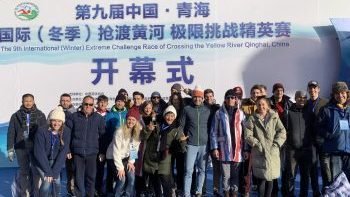
Among these, and very close to my heart, are endurance sports. While the most iconic event of the Olympics is widely considered to be the marathon, in the curious world of 2020 it is not seen so much as the pinnacle of endurance, but an initiation into a world of much more grueling tests of physical and mental exertion. The most popular incarnation of these are known as ultra-marathons. Every event which goes beyond the 42km (26.2 mile) distance is considered to be an ultra-marathon, with the 50km and 100km being the most popular versions, but with many going well beyond that. One would assume such masochistic endeavors are the reserve of a small and uniquely disturbed set of individuals, but the popularity of these events quickly belies that assumption.
In 2009, my first year in China, I would go for evening jogs around some of Beijing’s small man-made lakes and it would be a rare surprise to encounter even a single other jogger along the way. These days you will encounter dozens of other joggers along the most popular routes of the city regardless of the time of day, morning through evening. From virtually none ten years ago, there were 1,581 marathons held in 2018, and while ultra-marathons naturally have a smaller pool of participants, there was still a whopping 450 events in 2018. That is an average of 9 events per weekend where each participant is required to go for at least 50km…no small feat.
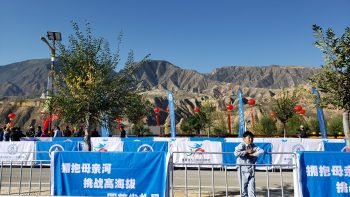
This development has been a boon for events, sportswear, travel, hospitality and plenty of other industries. The addictive nature of the sport ensures loyal customers, and China’s immense geographical variety means that participants can have their pick when choosing races. Be it the lush rainforest of southern Guangxi province, the arid desert of Gansu, or the snow-capped Himalayas, runners are spoiled for choice and constantly on the lookout for another fix. One of the world’s most famous marathons now takes place every year at what is perhaps China’s most internationally famous icon: the Great Wall. With hundreds of meters in elevation gain, no runner will be brazen enough to try for a new personal best time, but the stature of the Great Wall Marathon has become such that the race is now dominated by people who make the trip to Beijing solely for the purpose of completing the gruelling race.
If you are feeling up to the challenge, make sure to contact the Imperial Tours team who can arrange a customized tour before or after you take part in the race. After all, the Great Wall is just the beginning of an amazing China experience.
– Jaime is one of Imperial Tours’ Itinerary Designers.
Just to the south of Hong Kong lies Macau. This tiny territory of just under thirty square kilometers must be one of the few places in the world where a former colony boasts a higher per capita income than the parent country. Macau was settled while the Portuguese were acting as middlemen for trade between the Chinese and Japanese during the sixteenth century. These days it is internationally known for the casinos, whose revenues now better those of Las Vegas, but beneath that all-encompassing industry a small segment of Europe has lived on inside the Chinese world. The British poet, W. H. Auden, visited many years ago and wrote a poem which began: A weed from Catholic Europe, it took root Between the yellow mountains and the sea, And bore these gay stone houses like a fruit, And grew on China imperceptibly … And finishes with a line that Auden presumable meant as a slight ‘and nothing serious can happen here’. but which may have helped preserve some of the charm and tastes of the Portuguese world. These range from the ruins of the Church of St. Paul and a cemetery through which you can trace the history of the settlement, to the foods be they simple bread or substantial Macanese fare. Some of the numerous gaming revenues that the small territory which, like Hong Kong, has reverted to China, have been put to use in providing public services and expanding the university.
Wolfgang Puck, the famous Austrian-born American chef and restaurateur has brought his acclaimed American casual dining concepts to China for the first time. Wolfgang’s new hot spot is perfectly situated in the hip and affluent shopping and eating district of Xintiandi in Shanghai. And as there was a new celebrity chef restaurant in Shanghai, my friend and I felt obliged to experience it first hand. The outside of the restaurant was inviting with a soft gray brick exterior contrasting with rich wooden doors and flowing metal vines swirling through the windows. Walking in, we found the restaurant was quite full, with over two thirds of the place filled up. The décor inside made use of natural materials to deliver a modern atmosphere with a casual and elegant feel. Wood floors, soft leather chairs, granite tabletops and exposed light fixtures exuded a warm and urban atmosphere. This minimalist concept created an elegant and casual feel, which extended to the seating area on the terrace. Since it was a beautiful spring day in Shanghai, we opted for a table outside. As we took our seats on the terrace we decided it was the perfect spot to watch the world go by on a Saturday afternoon as friends, couples and families made their way through the streets with parcels in hand and smiles on their faces. After we had settled into our seats a server immediately came over with a menu. The western style menu was not overly extensive, but it had something to satisfy everyone’s tastes. The menu featured some of Wolfgang’s signature dishes such as handmade pizzas as well as a selection of salads, steaks, roast chickens, seafood dishes, pasta and the best part – desserts. The price range of each item on the menu fell between the range of $15 for a salad to around $45 for a steak.
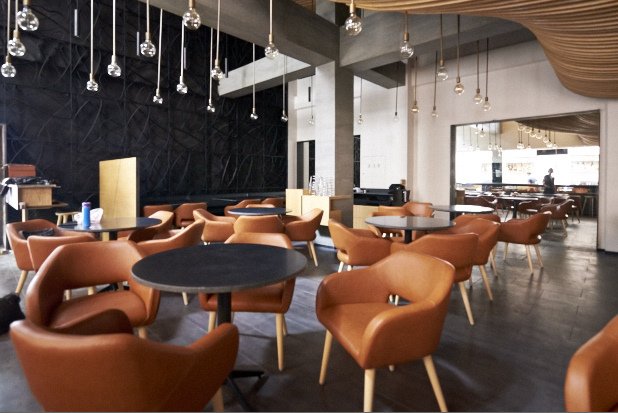
Urban interior décor
After going over the menu and discussing the pros and cons of each dish and what we were in the mood for, my companion opted for the Roasted Sea Bass accompanied by garlic spinach & charred lemon, while I decided on the Garlic & Herb Marinated Half Chicken with rosemary jus sauce. In addition to our mains we decided to share the Shrimp ‘Louie’ marinated in a tomato sauce as an appetizer and the Vanilla Bean Crème Brûlée with seasonal fruit for dessert. Following a casual catch up conversation our appetizer arrived. The Shrimp Louie turned out to be an excellent choice and a good portion to share between the two of us. Conversation ceased as we both tucked into the dish, agreeing we had made the right decision with the shrimp. After the remains of our starter were cleared away my companion and I continued to catch up on the happenings of our day-to-day lives while enjoying the lively atmosphere of Xintiandi’s pedestrian street. Xintiandi is one of the most popular shopping areas for young and well-to-do Shanghainese and foreigners alike so there is always something to see, do or eat.
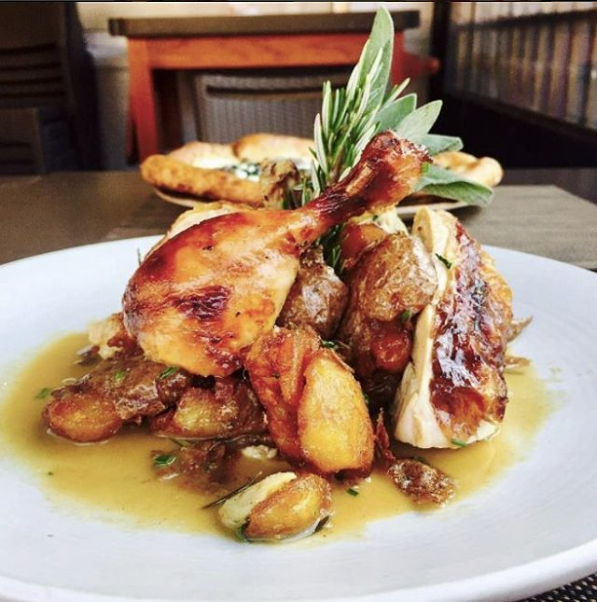
Garlic & Herb Marinated Half Chicken
Our food arrived in good time and when it did we discovered it had been a wise decision to share both the appetizer and dessert, as the portion size of our mains was huge. Although the bar & grill had a European meets Asia flair the portion sizes were certainly American. Our two mains could have easily fed a family of four. Never one to complain about too much of a good thing, my companion diligently began to eat her fish, while I endeavored to enjoy my chicken. After a chatty pre-meal conversation, silence ensued as we attempted to tackle our mains, that is until about half way through eating when I glanced up at my friend and in a defeatist tone admitted: “I don’t think I can finish this.” Looking up bemused, with a smile on her face she joked, “I don’t blame you. When it arrived I wasn’t sure whether you would eat the chicken or the chicken eat you!”

Créme Brûlée
By the time our Crème Brûlée arrived we were already full, but of course we had to try it. Like the other items we ordered the serving was quite large, presented in a dish the size of a soup bowl. With its golden-brown crust and vanilla-coloured crème hidden beneath, it looked too good not to try. Although rather sweet for my taste the Crème Brûlée had the perfect balance of crispiness and vanilla bean crème, it was absolutely delightful. I am not ashamed to admit that we finished the entirety of our dessert. At the end of it all both my companion and I were bursting! The bill for the two of us ended up being USD$120, without ordering drinks. Overall, our food was good. The star of the meal was the Crème Brûlée followed by the Shrimp Louie. Our mains were satisfactory, the chicken wasn’t too dry and the roasted bass was also well prepared, although nothing to write home about. However, it was the sheer size of the portions that was a bit intimidating and left the biggest impression. Overall, it seemed like a good place for families, as the menu had a large selection of child friendly options. The atmosphere was very family friendly as well – relaxed casual environment where parents and kids alike could relax and enjoy a good meal.
– Restaurant was reviewed by Lotus Qi, China Host at Imperial Tours.
Learn more about Imperial Tours’ unique culinary experiences here.
The Year of the Rooster
Chinese New Year, also referred to as Lunar New Year and Spring Festival, is the biggest and most important holiday in China. In terms of significance in Chinese culture the Lunar New Year is comparable to combining Thanksgiving and Christmas together. We have assembled some traditions and facts behind one of the world’s largest celebrations to provide a better understanding of this holiday. We have also put together some useful travel tips should you wish to experience this festival first hand.
The tradition of Chinese New Year is said to have started thousands of years ago when, at the end of a cold and hard winter, a mythical beast called Nian would storm into Chinese villages and devour all the men, women and children residing there. Full of fear and with no means to defend themselves the villagers would hide in the surrounding bamboo forests to wait out the night and the wrath of the beast. Until one year, tired of hiding, a brave old man decided to face the beast alone. In preparation for his fateful encounter, the old man hung up red flags and banners; he then cut fresh bamboo to light a fire. Once on fire the green bamboo created such loud cracking sounds that the monster, upon hearing the noise and seeing the many red colors, was scared away. And so as legend goes, from that day on people no longer had to fear the beast. Advancing forward thousands of years, it is now tradition that at the end of winter people across China gather together to celebrate, hang red banners and lanterns, wear red clothing and light firecrackers.
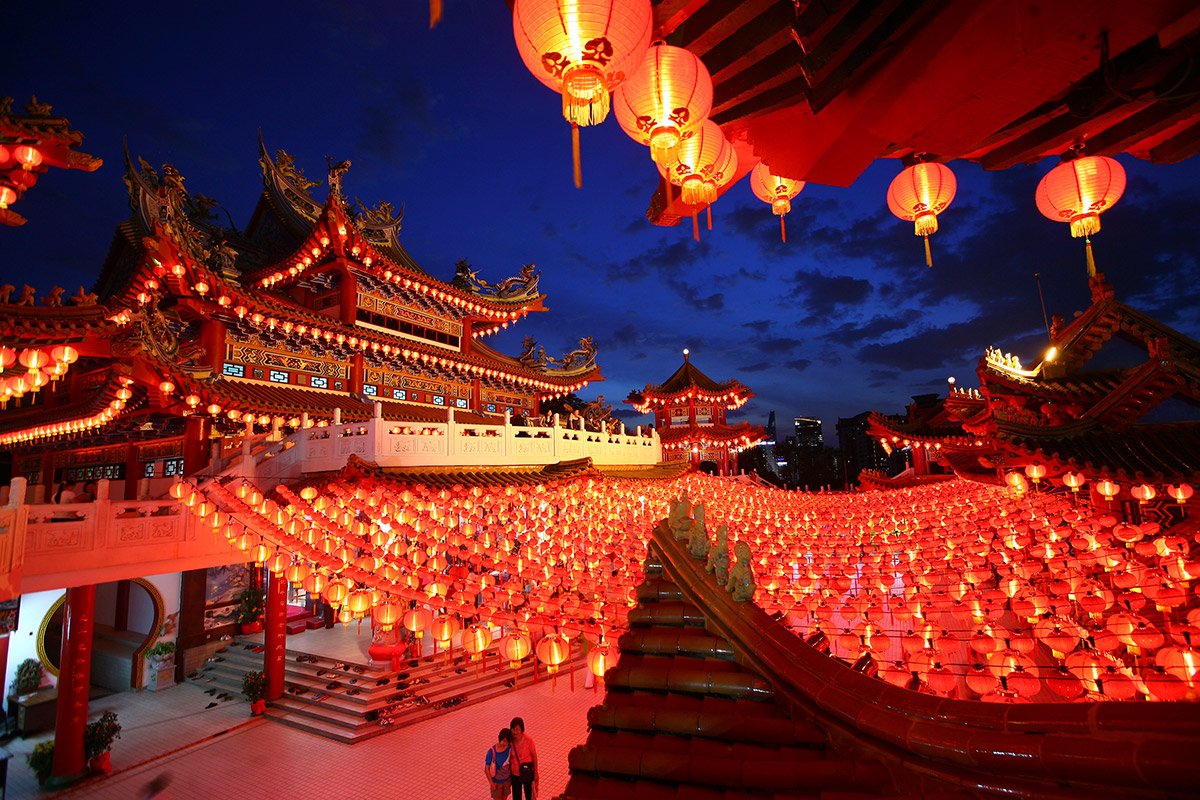
Red Lanterns in Beijing at Chinese New Year/span>
Chinese New Year is a 15-day celebration following the lunar calendar, this means that the date of the holiday changes each year. Generally, Chinese New Year falls between the end of January and the beginning of February. In 2017, January 28th was the first day of the New Year, marking the beginning of the year of the Rooster. Outside China countries such as Indonesia, Malaysia, South Korea, Taiwan and Singapore also recognize and celebrate the festival. Chinese New Year is actually the biggest migration on earth. Over the holiday there are an estimated 650 million people traveling, either throughout China or overseas to visit friends and family. Much like Christmas and Thanksgiving, in Chinese culture over the Lunar New Year it is customary for families to spend time together. For those individuals who have have moved into bigger centers, such as Beijing or Shanghai for work or study, the New Year festival is a time to travel home. For many people, this is the only time of year when they will have time to reunite with their families. Officially, this mass migration begins two weeks before New Years Eve and ends two weeks after; this transport period is referred to as Chun Yun. The Chinese New Year festival is also responsible for the largest television broadcast in the world. Since 1983, CCTV (China Central Television broadcasting company) has hosted a lavish six-hour Spring Festival Gala. The gala is called Chun Wan and is essentially a variety show featuring traditional Chinese performances showcasing China’s vast culture and history. With approximately 800 million viewers, this is the largest entertainment show broadcast globally. Since its origin, Chinese New Year has evolved to incorporate new customs and traditions, which can vary from place to place and family to family. However there are some universal traditions that the majority of those celebrating Chinese New Year recognize. We have created a list of seven common customs followed during the New Year festival.
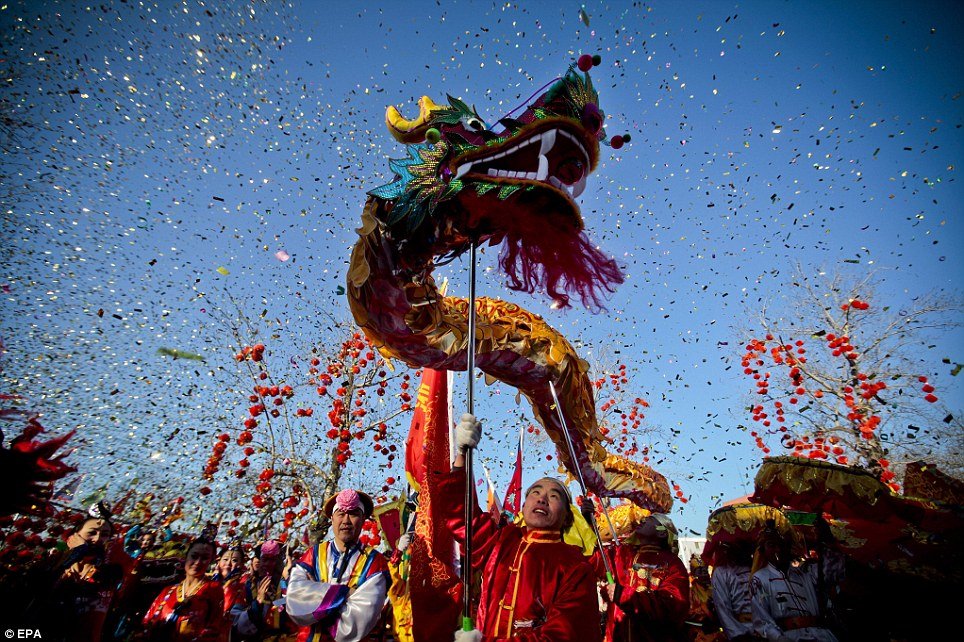
Traditional Chinese New Year Customs
Spring-Cleaning
Several days before the Lunar New Year is set to commence it is customary to perform a spring-cleaning of your home to sweep any ill fortune away. This is also the time to stock up on snacks and food to prepare for the festivities, much like what happens in the days prior to Christmas. This preparation is important as during Chinese New Year it is believed that one should do as little work as possible. It is also considered bad luck to use a knife, light a fire or even use a broom on the first day of the New Lunar Year.
Traditional Red Clothing & Decorations
In line with tradition, at Chinese New Year it is customary to decorate your home with traditional red lanterns and red banners. Across China red banners with auspicious poems written on them are hung outside doors to bring good fortune, wealth, happiness and longevity. In ancient China, New Year was also typically the time when people bought or traded for new clothing. In present-day China, it is customary to buy and wear red clothing, even underwear during this period.
Family Gatherings
It is traditional on New Years Eve for the family to congregate at the husband’s family home, then, on the second day of the New Year, the family would go to their maternal relatives for a visit and celebration. However, during the Lunar Festival the theme is generally ‘the more the merrier’ and generally distant relatives will gather together to celebrate regardless of family ties.
Lucky Foods
Symbolism in China is of utmost importance; even the food that is served and consumed during the New Year festival holds significance. Traditionally, fish is eaten for the New Year’s meal. In Chinese the word fish (yú) sounds similar to the Chinese word for ‘surplus’. Fish is consumed to ensure that each year there will be surplus. However, the fish is never eaten completely as this again symbolizes surplus. Other ‘lucky’ foods include mandarin oranges (júzi) as their name is a homophone of the word for success in Chinese. Another popular food with homophonic meaning is Niangao or glutinous rice cake, which sounds like ‘a more prosperous year’. Additionally, spring rolls and dumplings are eaten because of their similarities to ancient Chinese silver and gold ingots.
Firework Displays
In line with the tradition to scare away the Nian, at midnight on New Years Eve, to ring in the New Year people all over China go outside to set off a barrage of firecrackers and fireworks. However, this practice is not restricted to New Years Eve alone, every night for the next two weeks fireworks are lit until the last day of the festivities when anything that is left is set off.
Temple Visits & Temple Fairs
After the festivities and fireworks the night before, on the morning of New Years Day people congregate at Buddhist temples to give their offerings to the gods. While not everyone in China practices Buddhism, many Buddhist traditions have intermixed with folk customs and it is customary to burn incense at the temples as well as make a donation to wish for a smooth and successful next year. This is often combined with a visit to a traditional temple fair.
Traditional Gifts The five days following New Year’s Day are dedicated to eating, drinking, visiting relatives and playing mahjong. During this time it is traditional for older relatives to give children gifts of red envelopes with money called Hong Bao. The values vary from family to family, but typically Hong Bao’s consist of monetary values containing lucky numbers such as 6, 8 or 9. With the advancement of technology it has now also become popular for friends and family to send each other Hong Bao’s over the messaging service Wechat.
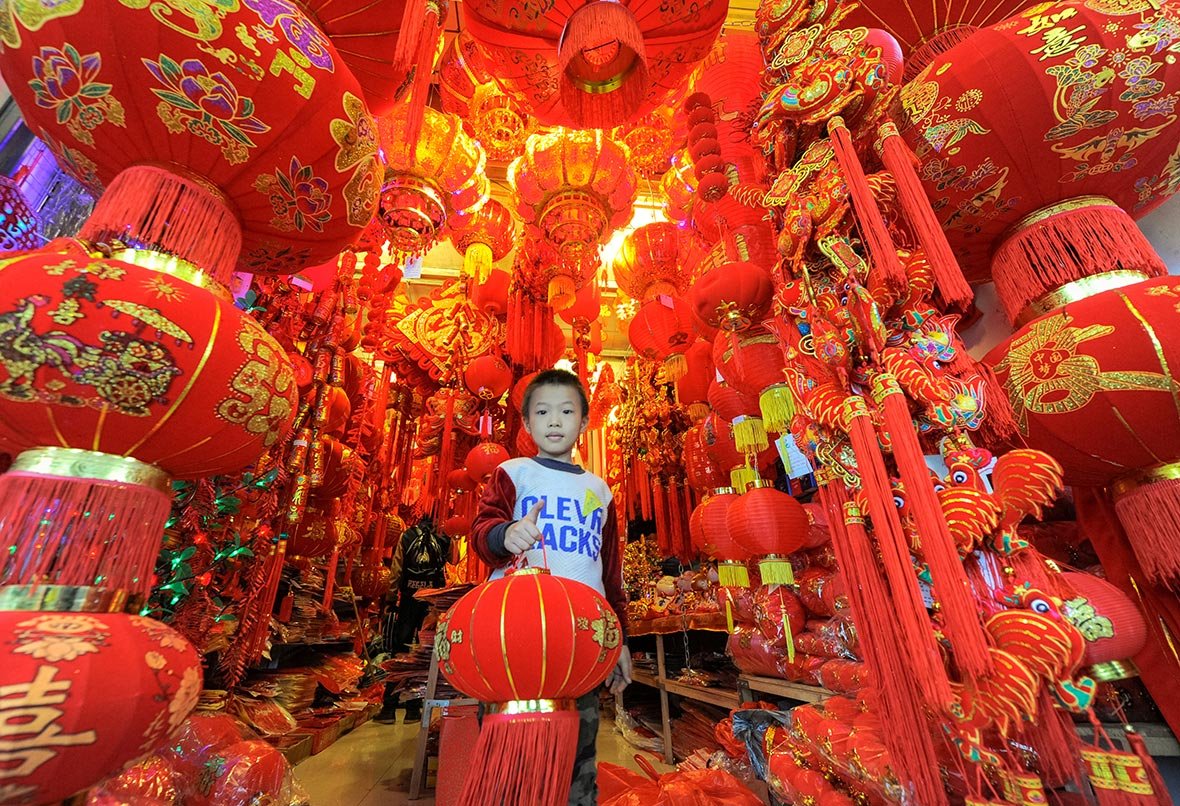
Traveling During the Chinese New Year Festival
Because most businesses are closed for the holiday, we do no recommend traveling during the first week of Chinese New Year. However, in the second week business starts to picks up again, as people return from their holidays the hustle and bustle of modern China slowly returns. If you do wish to come during this period there are some fun and cultural experiences we recommend doing.
Attend a Temple Fair
Visiting a Chinese New Year Temple Fair, called a Miao Hui, is a great way to experience Chinese culture around the Spring Festival. These temple fairs are set up in large city parks and feature arts and crafts as well as traditional performances. Many temple fairs have evolved into bazaar-like events with parts of the park dedicated to arcades where one can try one’s luck at winning an oversized teddy bear and various other prizes. These fairs are also great for trying a multitude of traditional Chinese snacks that are often only available during Chinese New Year.
Fireworks
Over 2,000 years ago China invented fireworks, so it is no surprise that watching and lighting fireworks during the New Year festival can be quite inspirational. On every large street corner temporary shops set up selling boxes of fireworks of various types. During the festival you can expect to see firework displays every evening. In recent years the government has tried to discourage citizens from lighting fireworks in the city due to fire hazards, but this rule goes largely ignored and is often not enforced.
Chinese Zodiac Animals
|
|
Characteristics |
Years |
|
Rat |
Intelligent, adaptable, quick-witted, charming, artistic & sociable. |
2020, 2008, 1996, 1984, 1972, 1960, 1948 & 1936 |
|
Ox |
Loyal, reliable, thorough, strong, reasonable, steady & determined. |
2021, 2009, 1997, 1985, 1973, 1961, 1949 & 1937 |
|
Tiger |
Enthusiastic, courageous, ambitious, leadership, confidence & charismatic. |
2022, 2010, 1998, 1986, 1974, 1962, 1950 & 1938 |
|
Rabbit |
Trustworthy, empathic, modest, diplomatic, sincere, sociable & caretakers. |
2023, 2011, 1999, 1987, 1975, 1963, 1951 & 1939 |
|
Dragon |
Lucky, flexible, eccentric, imaginative, artistic, spiritual & charismatic. |
2024, 2012, 2000, 1988, 1976, 1964, 1952 & 1940 |
|
Snake |
Philosophical, organised, intelligent, intuitive, elegant, attentive & decisive. |
2025, 2013, 2001, 1989, 1977, 1965, 1953 & 1941 |
|
Horse |
Adaptable, loyal, courageous, ambitious, intelligent, adventurous & strong. |
2026, 2014, 2002, 1990, 1978, 1966, 1954 & 1942 |
|
Sheep |
Tasteful, crafty, warm, elegant, charming, intuitive, sensitive & calm. |
2027, 2015, 2003, 1991, 1979, 1967, 1955 & 1943 |
|
Monkey |
Quick-witted, charming, lucky, adaptable, bright, versatile, lively & smart. |
2028, 2016, 2004, 1992, 1980, 1968, 1956 & 1944 |
|
Rooster |
Honest, energetic, intelligent, flamboyant, flexible, diverse & confident. |
2029, 2017, 2005, 1993, 1981, 1969, 1957 & 1945 |
|
Dog |
Loyal, sociable, courageous, diligent, steady, lively, adaptable & smart. |
2030, 2018, 2006, 1994, 1982, 1970, 1958 & 1946 |
|
Pig |
Honorable, philanthropic, determined, optimistic, sincere &sociable. |
2031, 2019, 2007, 1995, 1983, 1971, 1959 &1947 |

Beijing Pine Valley – with an impressive background of the Yan mountains, the par 44th is a good driving hole
China is now home to thousands of golf courses, as the sport has taken off in a big way. Some of the clubs play host to major world tournaments and there are now excellent courses all over the country. Here we’ve compiled a list of the best courses that can be accessed from the main tourist spots. Take a day out of your busy touring schedule to enjoy a round of golf in any of these top 5 clubs.
Beijing Pine Valley (Golden Bear)
If you are in Beijing for sightseeing, then don’t miss the opportunity to enjoy a day at Reignwood Pine Valley, a 2 square mile multifunction resort designed by Jack Nicklaus featuring four golf courses totaling 54-holes.
It is the first by-invitation-only golf club in China and is located near the Great Wall at Badaling close to the Yan Mountains. It became of international interest in 2015 when it hosted the 14th edition of the Johnnie Walker Classic, won by the Australian Adam Scott.

Sheshan has several natural features built into its course
Sheshan International Golf Club, Shanghai
Located in Shanghai, this is another golf course you should not miss if you want to escape the city and enjoy its scenery of 1000 year-old Gingko trees, waterways, and a natural quarry. The 18-hole (7266 yards/ par 72) course was designed by Nelson & Haworth.
Sheshan has hosted PGA Tour players such as Tiger Woods and Phil Mickelson, and last year among its accomplishments it won the “Top Club in China” award by Golf Magazine.
In order to be a challenging course – tree-lined fairways, water hazards and bunkers are strategically placed; therefore good technique is needed to get a good par. All along the course there is a mix of easy and difficult holes to test your ability.
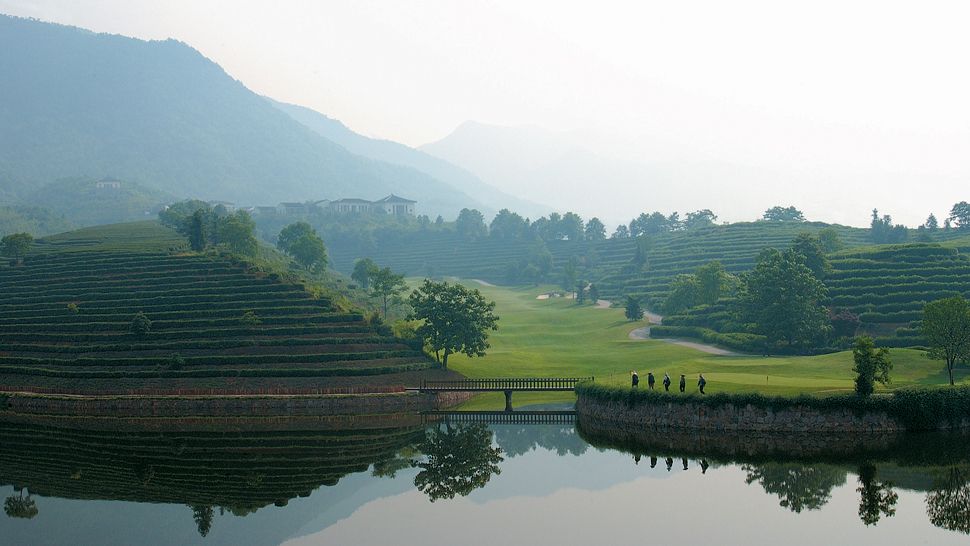
Fuchun Resort golf club, set amongst terraces of tea plantations near Hangzhou
Hangzhou Fuchun Resort Golf
Near Hangzhou, the Fuchun Resort’s golf course is waiting for you. It is an 8-hole, 72-par golf course designed by Daniel J. Obermeyer and located in the middle of a tea plantation. The golf course is designed to challenge golfers no matter your skill level. It also offers training facilities and coaching.

Set amongst the impressive natural scenery of the Stone Forest near Kunming
Stoneforest International Country Club
Located near Kunming, in the province of Yunnan in southwest China, you will discover this unique country club with three courses set in the Stone Forest, a UNESCO world heritage site.

The three 18-hole international golf courses were designed by Brian Curley. Leaders' Peak (7,528 yards) is the newest course and the most impressive of the three. The unique rock formations of the Stone Forest are found all over this course. Yufeng Ridge (7,241 yards) has the best views of all three courses. Meanwhile Masters' Resort (7,203 yards) was created to be the tournament course so is one of the best for playing.
This country club also has a wine cellar, a driving range and a restaurant offering fine Asian and Western cuisine. You can stop off here en route to Lijiang.
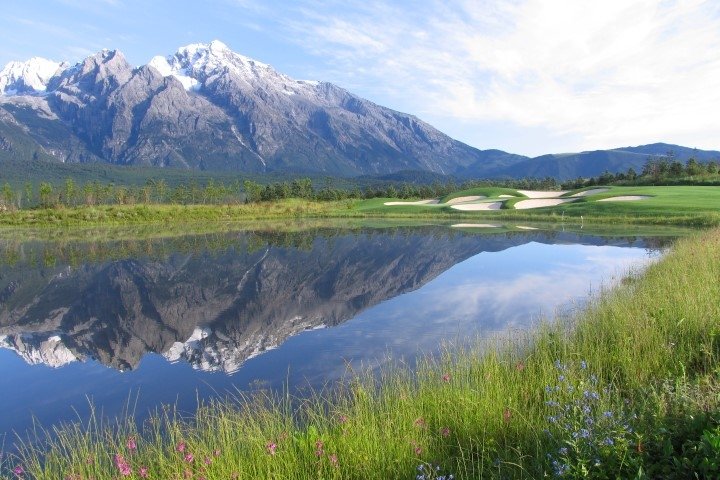
The second highest golf club in the world sits beneath Jade Dragon Snow Mountain near Lijiang
Lijiang Jade Dragon Snow Golf Club
Located in a valley facing the famous Jade Dragon Snow Mountain you will discover the highest golf club in Asia and the second highest in the world. It sits at an elevation of 10,800 ft. (3,290m) above sea level – this means balls fly 15%-20% further than at sea level! The golf club is 8548 yards long, which is the longest par 72 golf course in the world. If you are planning a trip to Lijiang then don’t miss the opportunity to experience golf at its highest point!
For more information on incorporating a round of golf into your China luxury holiday then please contact us or one of our preferred travel agents.
Running a marathon is a unique experience. Every step takes you through beautiful landscapes, people cheering you on, pain, ups and downs, more pain, and then you finally see the finish line – it’s over, you accomplished a marathon! Now, imagine how remarkable this experience would be if you combined it with some of the most exotics landscapes in China? Well, the marathon season is here so choose your destination and put on your running shoes!
Beijing Great Wall Marathon
The Great Wall Marathon is on 21 May. This could be an epic way to discover the Great Wall and its surrounding villages. By the end of the course you will not only have accomplished this amazing challenge, but also climbed 5,164 steps in one of the most unique marathons you can think of!
The marathon takes place near Beijing and all runners are invited. You can choose among three distances: Full Marathon, Half-Marathon and the 8.5K Fun Run.

Shangri-La Ultra Trail – for the fittest of the fit
Shangri-La Marathon
Also in May 2016 you can experience the ultramarathon and marathon in Shangri-La. Shangri-La is located in Yunnan Province and is considered to have the highest-quality air in all of China. Shangri-La Marathon organizes two Ultra Trails for the trail-addicted runners of 100K and 55K, as well as 45K and 24K. You will be running in the Meili Snow Mountains, which is part of the vast chain of the Himalaya.
For the 100K Ultra Trail runners the terrain is difficult and diverse with ascents ranging to 17,350 ft (5,288m). The 100K Ultra Trail will take you running on glaciers as well as through forests and alongside waterfalls – the landscapes here are simply stunning!
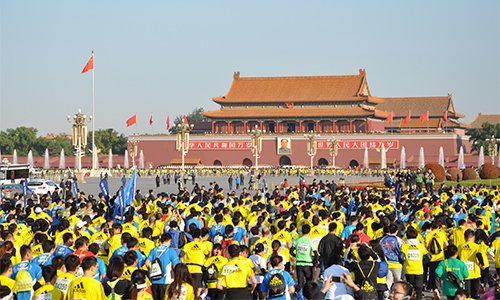
Starting line in Tian’anmen Square for the Beijing marathon
Beijing and Shanghai Marathons
Who said you couldn’t visit a city running? Both the Beijing and Shanghai Marathons will guide you through the heart of these incredible cities.
Beijing International Marathon will take you from the starting line at Tian’anmen Square to an Olympic ending line in the Olympic Park, where the Olympics Games took place in 2008.
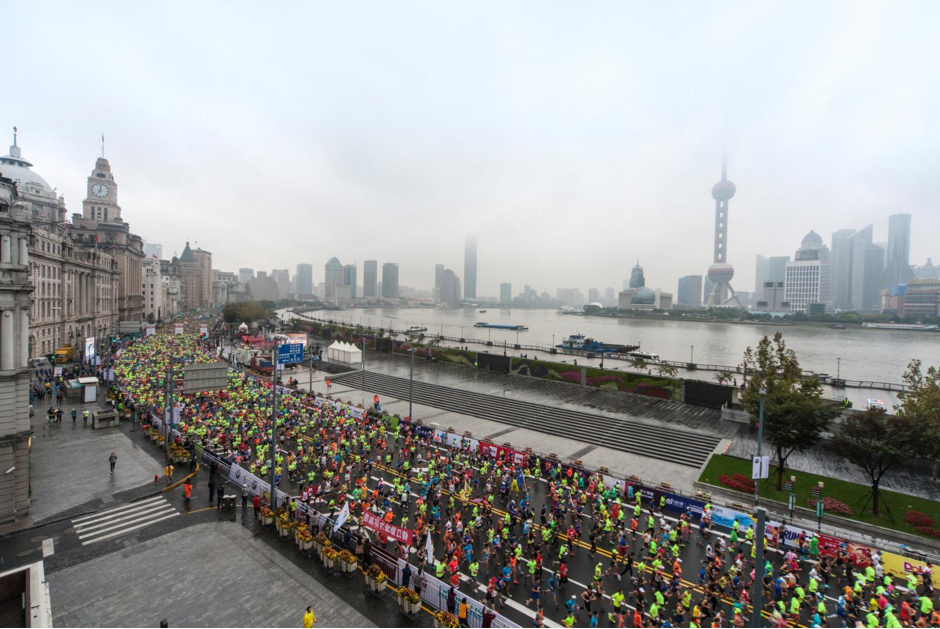
Views of The Bund at the International Shanghai Marathon
Shanghai International Marathon starts at The Bund (Zhongshan Dong Yi Lu), goes around the city heading south, passing Longhua Temple & Pagoda, and finishing at the Shanghai Stadium.
Even though the official dates for both International Marathons have not yet been confirmed, in 2015 they were in September and November respectively. But don’t worry – if you are not planning your trip during these months but still want a challenge there are other marathons and races planned for different dates in both cities.
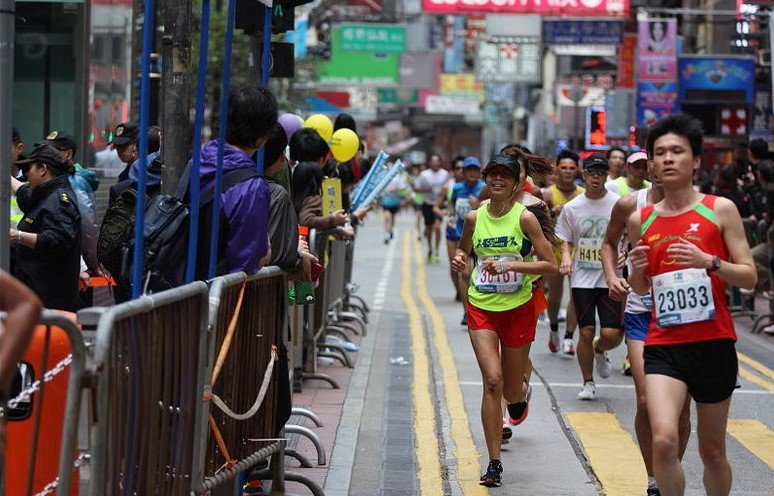
The Hong Kong marathon is usually held during the cooler months of winter
Hong Kong Marathon
The next Hong Kong marathon will take place on 12 February 2017 so you can save the date. It features various categories for all levels: Marathon, Half-Marathon, 10K, 10K Wheelchair Race and 3K Wheelchair Race.
Starting in Tsim Sha Tsui in Kowloon, the marathon will lead you to Tsing Yi Island and then back to Kowloon from where you will be treated to fantastic views over Victoria Harbor. You will then cross to Hong Kong Island for the last few miles along Hennessy Road until the finish line in Victoria Park.
If you are planning a trip to China and want to add these running experiences to it then please contact us.
I’m sitting here waiting for the blood moon to peer over the horizon on this day of the Mid-Autumn Festival, also called the Moon Festival. It takes place on the 15th day of the 8th month of the lunar calendar and is a celebration of the roundest and brightest moon of the year. It is a time when families come together to give thanks for the harvest. Even those relatives who cannot physically reunite for the festivities can take comfort by looking at the full round moon and knowing that their family members are doing the same. One of the traditions of the holiday is to make and eat moon cakes. Traditionally round, the moon cakes symbolize unity of family.
There are three legends associated with the Mid-Autumn Festival. Here they are, as told by my older daughter, a 2nd grader at the Chinese American International School in San Francisco, the first Mandarin immersion school in the United States:
Chang’e
Once there were ten suns and they were going to destroy the earth by rising at the same time. Houyi, an archer, was summoned by the emperor and he shot down nine of the suns and saved the earth. For his good deeds, he was offered a gift. Houyi was a greedy man and he wanted to live forever, so he asked for and received an elixir of immortality. Chang’e, Houyi’s wife, knew he was a greedy man and so she stole the elixir and ran away with it. Houyi chased her. As he was catching up to her, she drank it to escape and she was lifted to the moon. You can see her in the moon on the Mid-Autumn Moon Festival.
Jade Rabbit
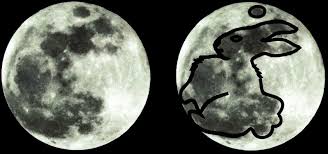
Once there were three moon magicians who came to earth. Changing themselves into men, they pretended they had nothing to eat. They were trying to see who could give them the best food. The fox gave them berries and the monkey gave them other fruits. The rabbit had nothing to give, so he gave himself. The magicians were so impressed that they took him to the moon to live with them. Sometimes you can see him on the moon. He gives food, ensuring a good harvest. He makes moon cakes and throws them down from the moon for the Mid-Autumn Festival and you can see him up on the moon with Chang’e.
Wu Gang the Woodcutter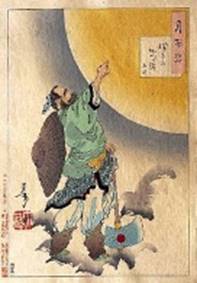
Once there was a selfish woodcutter. He wanted to know the key to eternal life. An old hermit promised to teach him the secret but he had to do everything the hermit told him to do. But the woodcutter was a lazy man so whenever he was asked to do something, he would take a nap under a tree. The hermit revealed his true identity; he was the Jade Emperor. The woodcutter was scared and begged for one last chance. The Jade Emperor said no and took him to the garden on the moon. He said, “You must cut this tree and if you stop for even one minute, you will wither away and die.” The woodcutter thought to himself, “that’s easy because I’m a woodcutter, after all.” He started to cut the tree but when he did, it healed itself right away. And from then on, you can always see him on the moon chopping the tree and filling the air with the scent of cinnamon.
Imperial Tours' Managing Partner Nancy Kim gives Luxury Travel Advisor some recommendations on where's hot to shop in Beijing right now!
